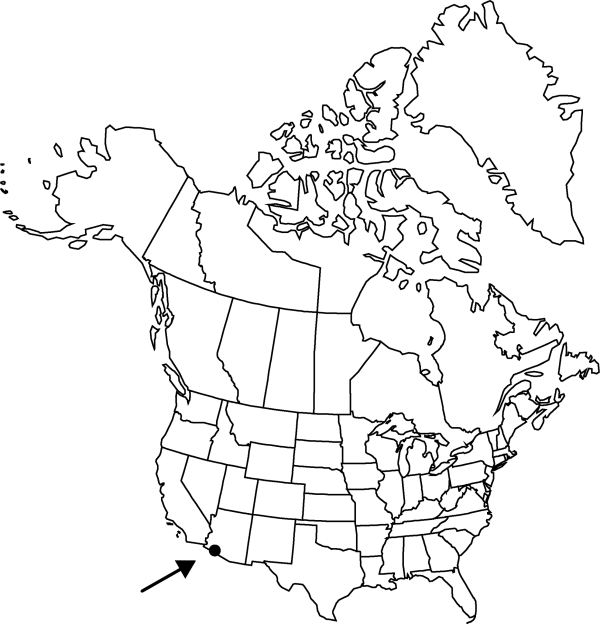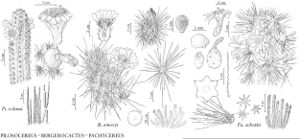Difference between revisions of "Pachycereus schottii"
Bradleya 5: 93. 1987.
FNA>Volume Importer |
FNA>Volume Importer |
||
| Line 26: | Line 26: | ||
}}<!-- | }}<!-- | ||
| − | --><span class="statement" id="st- | + | --><span class="statement" id="st-undefined" data-properties=""><b>Shrubs </b>[to small trees], with basal branches sometimes rooting to form thickets. <b>Stems</b> green with red around young areoles, aging gray-green with faint waxy chevrons; ribs somewhat rounded, margins relatively flat; areoles 1–1.5 cm apart on rib crest, shield-shaped, on proximal stems 1 cm wide, those on distal stems closer together, circular; young hairs whitish gray, short. <b>Spines</b> strongly dimorphic, those on proximal stems usually 7–10 per areole, rose-red, aging gray, stout, usually 5–7 mm, to less than 30 mm, weakly differentiated as central and radial spines, those on distal stems usually more than 15 per areole, gray to blackish (rarely aging copper-brown), thin, flattened, twisted, to 7.5 cm; bristles 4–10 cm. <b>Flowers</b> lateral on stems, often several per areole, on specialized bristle-forming or transition areoles, short funnelform, 3–4.5 × 2–3 cm; flower tube thin walled, very narrow, less than 1.5 cm; nectar chamber open; scales rose with green margins; tepals spreading, reflexed by morning; outer tepals somewhat fimbriate, minutely papillate; inner tepals 25, with pink-orange center, 11–16 mm, apex acute; stamens 100, white, turning pink by next morning, to 2 cm; anthers cream; ovary small, tubercles and spines absent; styles white, short, narrow; stigma lobes erect, relatively short. <b>Fruits</b> candy-apple red, when immature greenish, ovoid to subspheric, 25–40 mm. <b>Seeds</b> helmet-shaped, often with a prominent raphe. <b>2n</b> = 22.</span><!-- |
-->{{Treatment/Body | -->{{Treatment/Body | ||
| + | |phenology=Flowering late Mar–Sep[-Dec]; fruiting often 1 month after flowering. | ||
|habitat=Cercidium-Larrea-Olneya-Carnegiea communities, around washes, on sandy [gravelly] soils | |habitat=Cercidium-Larrea-Olneya-Carnegiea communities, around washes, on sandy [gravelly] soils | ||
|elevation=400-500 m | |elevation=400-500 m | ||
| Line 50: | Line 51: | ||
|basionyms=Cereus schottii | |basionyms=Cereus schottii | ||
|family=Cactaceae | |family=Cactaceae | ||
| + | |phenology=Flowering late Mar–Sep[-Dec]; fruiting often 1 month after flowering. | ||
|habitat=Cercidium-Larrea-Olneya-Carnegiea communities, around washes, on sandy [gravelly] soils | |habitat=Cercidium-Larrea-Olneya-Carnegiea communities, around washes, on sandy [gravelly] soils | ||
|elevation=400-500 m | |elevation=400-500 m | ||
| Line 57: | Line 59: | ||
|publication year=1987 | |publication year=1987 | ||
|special status= | |special status= | ||
| − | |source xml=https://jpend@bitbucket.org/aafc-mbb/fna- | + | |source xml=https://jpend@bitbucket.org/aafc-mbb/fna-data-curation.git/src/9216fc802291cd3df363fd52122300479582ede7/coarse_grained_fna_xml/V4/V4_348.xml |
|subfamily=Cactaceae subfam. Cactoideae | |subfamily=Cactaceae subfam. Cactoideae | ||
|genus=Pachycereus | |genus=Pachycereus | ||
|species=Pachycereus schottii | |species=Pachycereus schottii | ||
| − | |||
| − | |||
| − | |||
| − | |||
| − | |||
| − | |||
| − | |||
| − | |||
| − | |||
| − | |||
| − | |||
| − | |||
| − | |||
| − | |||
| − | |||
| − | |||
| − | |||
| − | |||
| − | |||
| − | |||
| − | |||
| − | |||
| − | |||
| − | |||
| − | |||
| − | |||
| − | |||
| − | |||
| − | |||
| − | |||
| − | |||
| − | |||
| − | |||
| − | |||
| − | |||
| − | |||
| − | |||
| − | |||
| − | |||
| − | |||
| − | |||
| − | |||
| − | |||
| − | |||
| − | |||
| − | |||
| − | |||
| − | |||
| − | |||
| − | |||
| − | |||
| − | |||
| − | |||
| − | |||
| − | |||
| − | |||
| − | |||
| − | |||
| − | |||
| − | |||
| − | |||
| − | |||
| − | |||
| − | |||
| − | |||
| − | |||
| − | |||
| − | |||
}}<!-- | }}<!-- | ||
-->[[Category:Treatment]][[Category:Pachycereus]] | -->[[Category:Treatment]][[Category:Pachycereus]] | ||
Revision as of 14:06, 27 July 2019
Shrubs [to small trees], with basal branches sometimes rooting to form thickets. Stems green with red around young areoles, aging gray-green with faint waxy chevrons; ribs somewhat rounded, margins relatively flat; areoles 1–1.5 cm apart on rib crest, shield-shaped, on proximal stems 1 cm wide, those on distal stems closer together, circular; young hairs whitish gray, short. Spines strongly dimorphic, those on proximal stems usually 7–10 per areole, rose-red, aging gray, stout, usually 5–7 mm, to less than 30 mm, weakly differentiated as central and radial spines, those on distal stems usually more than 15 per areole, gray to blackish (rarely aging copper-brown), thin, flattened, twisted, to 7.5 cm; bristles 4–10 cm. Flowers lateral on stems, often several per areole, on specialized bristle-forming or transition areoles, short funnelform, 3–4.5 × 2–3 cm; flower tube thin walled, very narrow, less than 1.5 cm; nectar chamber open; scales rose with green margins; tepals spreading, reflexed by morning; outer tepals somewhat fimbriate, minutely papillate; inner tepals 25, with pink-orange center, 11–16 mm, apex acute; stamens 100, white, turning pink by next morning, to 2 cm; anthers cream; ovary small, tubercles and spines absent; styles white, short, narrow; stigma lobes erect, relatively short. Fruits candy-apple red, when immature greenish, ovoid to subspheric, 25–40 mm. Seeds helmet-shaped, often with a prominent raphe. 2n = 22.
Phenology: Flowering late Mar–Sep[-Dec]; fruiting often 1 month after flowering.
Habitat: Cercidium-Larrea-Olneya-Carnegiea communities, around washes, on sandy [gravelly] soils
Elevation: 400-500 m
Distribution

Ariz., Mexico (Baja California, Baja California Sur, Sinaloa, Sonora).
Discussion
Pachycereus schottii is primarily a Mexican species occuring in southernmost Arizona only in Organ Pipe Cactus National Monument at nine sites very close to the international boundary, where winter temperatures do not generally reach freezing. The Arizona populations do not appear to be experiencing much recruitment via seeds, but persist by vegetative propagation. In Mexico, plant height, rib number, and rib shape vary considerably with microhabitat. In subtropical thorn forest P. schottii may be a small tree with a very short trunk. Three varieties of P. schottii were formally recognized (G. S. Lindsay 1963) but need to be re-examined using DNA techniques. If varieties or subspecies are accepted, Arizona populations would represent the typical form.
In contrast to other species of Pachycereus, P. schottii and its narrowly restricted cousin P. gatesii of Baja California Sur, Mexico have the smallest flowers and seeds and the most fleshy and naked fruits. The flowering portion of each adult stem always has long, grayish bristles, inspiring the anthropomorphic vernacular names referring to old age.
The moth Upiga virescens (Pyralidae) is the obligate pollinator of Pachycereus schottii, forming a mutualistic system comparable with the yucca and yucca moth (J. N. Holland and T. H. Fleming 1999, 1999b; R. S. Folger and A. D. Zimmerman 2000). In populations near the international border, flowers of P. schottii open ten minutes after sunset (J. N. Holland, pers. comm.).
Selected References
None.
